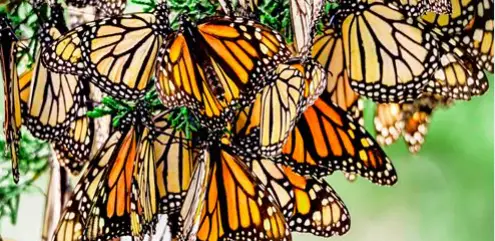
The monarch butterfly is one of the most iconic insect species in North America, with its genial nature and striking orange-and-black wings.
While there used to be millions of butterflies migrating throughout the continent, which stretches from Marin County in the north part of the state to San Diego County in the south, each winter, the latest numbers reveal a worrisome trend that could result in something never thought possible: monarchs could be close to extinction if more is not done to save them this coming spring and beyond.
Monarch Population Drops to Fewer Than 2,000
This year’s count was undertaken by the Xerxes Society, a nonprofit environmental organization focusing on the conservation of invertebrates.
Overall, only 2,000 monarch butterflies was recorded in the aforementioned stretch of California, down from 29,000 the previous year and 27,000 the year before. A total of 4.5 million were found in the 1980s, meaning that the population has now declined by a shocking 99.9% ever since.
The butterflies typically arrive in California at the beginning of November and then spread across the country when warmer weather arrives in March.
But habitat loss, pesticides, and other factors are now wiping them out in numbers far greater than is considered to be sustainable.
The butterflies have a hard time finding food and shelter, as they navigate a minefield of toxic glyphosate and other synthetic pesticides, genetically engineered monoculture crop fields, new electromagnetic frequencies from technology; and in 2020, wildfires in the California region.
“Volunteers didn’t see a single butterfly this year,” one observer said according an AP report.
Only a few hundred butterflies were spotted at traditionally popular spots for sighting them including the Pismo State Beach Monarch Butterfly Grove and Natural Bridges State Park.
“These sites normally host thousands of butterflies, and their absence this year was heartbreaking for volunteers and visitors flocking to these locales hoping to catch a glimpse of the awe-inspiring clusters of monarch butterflies,” said Sabrina Jepsen, the Society’s director of endangered species.
Aside from the estimated 97% population loss in Western migratory regions, butterfly numbers have dropped about 80% in the Eastern regions.
Meanwhile, a group of 80+ environmental organizations have urged Congress to provide $100 million in relief, in hopes of saving the Monarch butterflies from what could be a pending extinction.
Time is Ticking: How to Support the Monarch Butterfly Recovery
Aside from supporting organic and regenerative farmers, planting a pollinator friendly garden is an excellent way to support the recovery of monarch butterflies.
Pollinator-friendly gardens typically include large numbers of native plants, especially milkweed, the preferred and vital food source that most butterflies need to survive and thrive in the wild.
In recent years, millions of people have stepped up to the plate by planting these gardens, oftentimes in diverse combinations of native species that include milkweed and several other plants that provide food and shelter for native insects.
Milkweed is:
-The sole plant that caterpillars eat and where monarchs lay their eggs
-Disappearing in large part due to urbanization and pesticide use
-Oftentimes found directly in the middle of pollinator gardens, which could drew in hostile insects that threaten monarchs and their caterpillars’ maturation
Currently, researchers across the country are studying these gardens and plants to determine which layouts work the best, including Adam Dale, an assistant professor in entomology at the University of Florida, according to EcoWatch.
A study in the journal Insects from Dale’s team was undertaken to identify whether a diverse pollinator-friendly garden with wildflowers and milkweed would be preferable, or if a garden with just milkweed would be preferable.
A diverse assortment of native plants provides food for butterflies, but it also attracts more potential predator species.
Dale’s team found that areas with a mix of native swamp milkweed and other wildflowers saw an increase in monarch eggs compared to areas planted with just milkweed.
Even though there was an increase in the number of predatory insects, as suspected, it didn’t have an effect on the number of monarch larvae that survived.
“So what we were concerned about didn’t come through,” he said.
While the study was done in Florida, Dale says in general the findings should be applicable to monarch populations in other places.
“Our main goal is to try to create conservation habitat in urban areas where we’re replacing natural habitat with human habitat,” he says. “So ultimately we’re trying to figure out ways to integrate these types of gardens into our yards and green spaces, and just try to make them as good as they can be.”
With monarchs teetering on the edge of extinction, Dale hopes applying what they’ve learned from research like this can help make conservation efforts more successful.
“I hope that people who are interested in conserving monarchs and other insects will see this because I think it provides a little more evidence that helps inform how people create these types of gardens,” Dale says.
“Whether that’s a homeowner, a green-space land manager in an urban area, a golf course superintendent looking to create conservation habitat or anyone who’s creating these spaces, I think they could use this to improve the condition of the habitat they’re creating.”
For more information on Dale’s study, check out this blog post from the University of Florida here.
Dale’s team has also previously found that planting wildflowers on golf courses can greatly aid the conservation of pollinator habitat, as shown in this study.
A Simple Tweak to Help Monarchs in Your Pollinator Garden This Spring
A better setup for supporting the butterflies could be a garden with milkweed planted on the perimeter, according to a recent study from the University of Kentucky, which found that the insects do better with this setup.
In the 2020 study, researchers Adam Baker and Daniel Potter found that monarch eggs and larvae were 2.5 times more abundant in gardens with milkweed planted around the perimeter as opposed to those intermixed with the other plants.
They also found more monarch butterfly eggs and larvae on milkweed plants in gardens that had 100 meters of north-south access unobstructed by buildings or other structures, providing additional clues as to how pollinator friendly gardens can best be constructed.
For more information on the study, visit this link.
Thanks for installing the Bottom of every post plugin by Corey Salzano. Contact me if you need custom WordPress plugins or website design.




